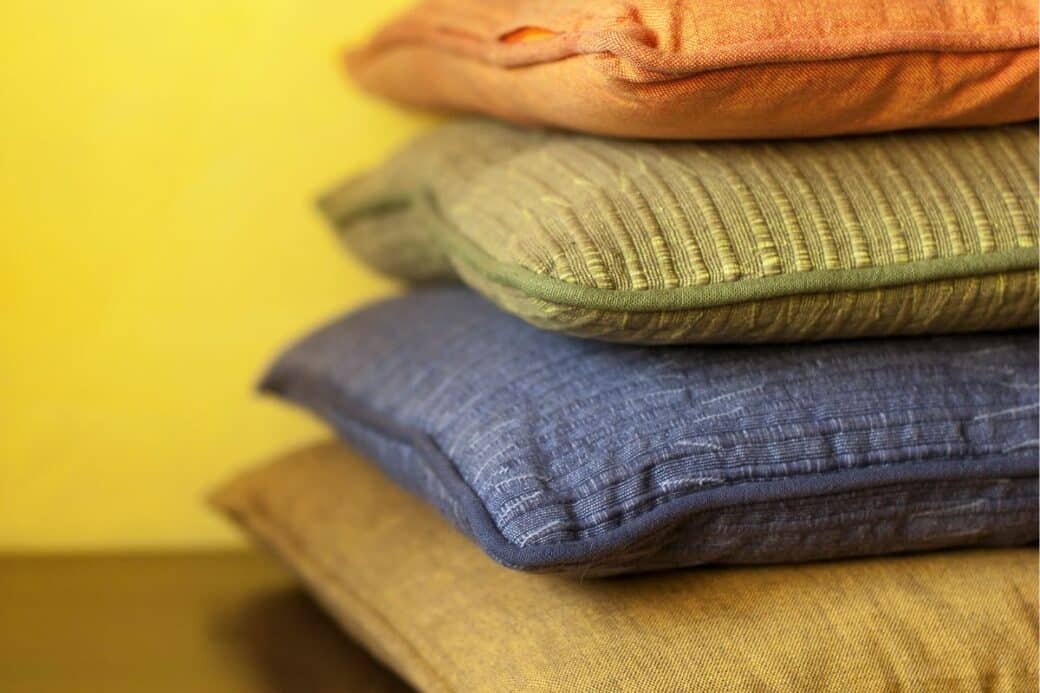Imagine sitting comfortably in your favorite meditation spot, feeling supported and grounded as you delve into your practice. The right meditation cushion can make all the difference in creating a serene and comfortable environment for your meditation sessions. But with so many options available, how do you choose the right fill for your meditation cushion? In this article, we will explore different types of meditation cushion filling, their benefits, and how to select the perfect one for your meditation needs. So, get ready to enhance your meditation experience and find your perfect seating companion.

Meditation Cushions Filling: Understanding The Importance of Meditation Cushion Filling
When it comes to meditation, having a comfortable and supportive cushion can significantly enhance your practice. The filling of the cushion plays a crucial role in providing both comfort and maintaining proper posture during sessions. Furthermore, the choice of filling can also impact the durability and lifespan of the cushion, as well as contribute to the overall success of your meditation practice.
Role of cushion filling in comfort and posture
The filling of a meditation cushion plays a vital role in providing the necessary comfort and support for your body during meditation. Sitting in a proper posture is key to maintaining focus and relaxation. A cushion with the right filling helps to distribute weight evenly, reducing pressure points and preventing discomfort. It provides a stable base, allowing you to sit for longer periods without strain on your body.

How filling impacts the durability of the cushion
The choice of filling also affects the durability and lifespan of your meditation cushion. Quality fillings are resilient and maintain their shape over time, ensuring that the cushion remains supportive and comfortable even with regular use. On the other hand, low-quality fillings may flatten or clump, leading to a decrease in cushion support and overall effectiveness.
Contribution of filling towards a successful meditation session
The filling in your meditation cushion can contribute to the success of your meditation session in several ways. First, the comfort provided by the filling allows you to focus your attention inward, without distractions from discomfort. Second, the proper support and alignment promote good posture, which aids in deepening your meditation practice. Lastly, the right filling can create a sense of stability and grounding, enhancing the overall sense of relaxation and calmness during your sessions.
Broad Categories of Meditation Cushion Fillings
Meditation cushion fillings can be broadly categorized into natural fillings and synthetic or man-made fillings. Each category has its own unique properties and benefits, catering to different preferences and needs.
Natural fillings
Natural fillings are derived from organic sources and are often favored by those seeking an eco-friendly option. These fillings are known for their breathability, moisture-wicking properties, and gentle support. They provide a closer connection to nature and can enhance the overall meditative experience.
Synthetic or man-made fillings
On the other hand, synthetic or man-made fillings are typically made from materials such as foam, polyester, or microbeads. These fillings are often more affordable and have distinct characteristics, such as high resilience and shape retention. They are an excellent choice for those looking for a firmer and more supportive cushion.
Exploring Natural Filling Options
Natural fillings offer a range of options that cater to different preferences and needs. Let’s take a closer look at some popular natural filling options for meditation cushions:
Kapok fillings
Kapok is a natural fiber extracted from the seeds of the kapok tree. It is known for its lightweight and fluffy texture, providing excellent support and comfort. Kapok fillings offer good breathability, allowing air circulation and reducing the risk of heat buildup during meditation. They are ideal for those who prefer a soft and plush cushion.
Buckwheat hull fillings
Buckwheat hulls are the outer shells of the buckwheat grain, and they make for a popular filling choice. These hulls conform to the shape of your body, providing customized support and maintaining proper posture during meditation. Buckwheat hull fillings are also known for their excellent breathability and moisture-wicking properties, keeping you cool and dry even during longer meditation sessions.
Spelt fillings
Spelt is a type of ancient grain that has gained popularity as a filling for meditation cushions. Spelt fillings offer a unique combination of softness and support. They conform to the contours of your body, providing a comfortable and personalized sitting experience. Spelt fillings are also hypoallergenic and mold-resistant, making them an excellent option for individuals with allergies or sensitivities.
Cotton fillings
Cotton is a natural and breathable material that offers a soft and supportive filling for meditation cushions. Cotton fillings provide a moderate level of support and can be easily adjusted to suit individual preferences. They are often a preferred choice for those looking for a vegan and eco-friendly option.
An In-depth Look: Kapok Fillings
What is Kapok
Kapok is a natural fiber that comes from the seed pods of the kapok tree. It is a fluffy and lightweight material that has been used for centuries as a filling for various products. The kapok tree is native to tropical regions and is known for its tall and majestic presence.
Pro’s and Con’s of Kapok filling
Kapok fillings offer several benefits for meditation cushions. They provide a soft and plush surface, allowing for maximum comfort during meditation. Kapok is also an excellent natural insulator, keeping you cool in warm weather and warm in colder temperatures.
One drawback of kapok filling is that it may compress over time and require periodic fluffing to maintain its shape. Additionally, individuals with allergies to natural fibers may need to consider an alternative filling option.
Who should choose Kapok filling
Kapok fillings are an excellent choice for individuals who prefer a soft and luxurious cushion. If you value breathability and a naturally insulating material, kapok can provide the ideal combination. However, if you have allergies or prefer a firmer cushion, alternatives may be a better fit for you.
Understanding Buckwheat Hull Fillings
What are Buckwheat Hulls
Buckwheat hulls are the protective outer shells of the buckwheat grain, and they are commonly used as a filling for meditation cushions. These shells are lightweight, hypoallergenic, and provide excellent breathability.
Advantages and disadvantages of Buckwheat Hull filling
Buckwheat hull fillings offer numerous advantages. Their malleability allows them to conform to your body shape, providing the perfect support and alignment for your meditation practice. They are also natural insulators, preventing the buildup of heat and maintaining a comfortable temperature during longer meditation sessions.
However, one potential drawback of buckwheat hull fillings is the rustling sound they may produce when shifting positions during meditation. Some practitioners find the sound distracting, while others see it as a reminder to stay present.
Ideal users of Buckwheat Hull filling
Buckwheat hull fillings are particularly suitable for individuals who prefer a firmer cushion that molds to the shape of their body. They are often recommended for individuals with back pain or those seeking optimal support and proper spinal alignment during meditation.
Delving Into Spelt Fillings
Definition of Spelt
Spelt is an ancient grain that has gained popularity as a filling for meditation cushions. It offers a unique combination of softness and support, making it an excellent choice for meditation practitioners.
Benefits and drawbacks of Spelt filling
Spelt fillings provide a comfortable sitting surface that conforms to the contours of your body. They are soft and plush, providing a luxurious feel during meditation. Additionally, spelt fillings are known for their hypoallergenic and mold-resistant properties, making them an ideal choice for individuals with sensitivities.
One potential drawback of spelt filling is that it may compress over time, requiring occasional readjustment or refilling to maintain its shape. Additionally, some individuals may find that the texture of spelt may not suit their preferences.
Who should opt for Spelt filling
Spelt fillings are a great option for individuals who desire a balance of softness and support in their meditation cushion. If you have allergies or sensitivities, spelt fillings offer a hypoallergenic and mold-resistant solution. However, if you prefer a firmer or more traditional filling option, alternatives may be better suited to your needs.
Discussing Cotton fillings
Pros and Cons of Cotton fillings
Cotton fillings offer various advantages for meditation cushions. They provide a soft and supportive surface, allowing for a comfortable sitting experience. Cotton is a natural and breathable material that offers excellent moisture-wicking properties, keeping you cool and dry during longer meditation sessions.
However, cotton fillings may compact over time and require occasional fluffing to maintain their shape. Additionally, they may not provide the firmness and moldability that some practitioners prefer for optimal support during meditation.
Who is it best fit for
Cotton fillings are well-suited for individuals who prioritize a soft and breathable cushion. If you value the natural properties of cotton, such as its moisture-wicking abilities, cotton fillings can offer a comfortable and supportive surface for your meditation practice. However, if you prefer a firmer or more moldable cushion, alternative options may better meet your needs.
Briefing Synthetic or Man-made Filling Options
While natural fillings have their appeal, synthetic or man-made fillings also offer unique advantages for meditation cushions. Let’s take a closer look at some common options:
Foam fillings
Foam fillings, such as memory foam or polyurethane foam, provide excellent support and shape retention. They conform to your body shape and offer a firm and supportive surface for meditation. Foam fillings are also durable and long-lasting, making them a popular choice for practitioners looking for a cushion that maintains its shape over time.
Polyester fillings
Polyester fillings are known for their resilience and low allergenic properties. They offer a firm and supportive surface for meditation and maintain their shape over time. Polyester fillings are also easy to clean and maintain, making them a convenient option for practitioners who prioritize ease of use.
Microbeads fillings
Microbeads are tiny, round beads made from plastic or PVC. They provide a unique texture that conforms to your body shape, offering personalized support during meditation. Microbead fillings are lightweight and retain their shape well. However, it is essential to note that microbeads are not eco-friendly and may not be suitable for practitioners with environmental concerns.
Choosing the Right Filling Based on Personal Needs
Selecting the right filling for your meditation cushion is a highly personal decision. Several factors should be considered to ensure a comfortable and supportive experience.
Consideration of comfort level
Think about what level of cushion softness or firmness is most comfortable for you. Some practitioners prefer a plush and soft cushion, while others prefer a firmer and more supportive surface. Experiment with different fillings to find the one that feels the most comfortable for your meditation practice.
Thinking about durability and lifespan
Consider the durability and lifespan of the filling you choose. Quality natural fillings and certain synthetic fillings, such as foam, are known for their long-lasting properties. This ensures that your cushion will maintain its shape and support over time, providing a consistent and reliable platform for meditation.
Factoring in ease of cleaning and maintenance
Consider the ease of cleaning and maintenance when choosing a filling. Natural fillings, such as buckwheat hulls or spelt, may require occasional refilling or fluffing to maintain their shape. Some synthetic fillings, such as polyester or foam, are easier to clean and maintain, making them a convenient option for those seeking low-maintenance meditation cushions.
Understanding personal allergies or sensitivities
If you have any allergies or sensitivities, it’s crucial to select a filling that is hypoallergenic and mold-resistant. Natural fillings like buckwheat hulls or spelt offer these properties, making them suitable for individuals with sensitivities. Synthetic fillings like foam or polyester are often low allergy and may be a better choice for those with specific sensitivities.
Thinking about environmental impact
Consider the environmental impact of the filling you choose. Natural fillings, such as kapok or cotton, are biodegradable and eco-friendly options. On the other hand, synthetic fillings like foam or microbeads may not be environmentally friendly and can contribute to plastic waste. If you prioritize sustainability and the environment, opt for a natural filling that aligns with your values.
Closing Thoughts on Choosing the Right Fill
Selecting the right filling for your meditation cushion is a process that requires time and consideration. It is essential to take your time in the selection process, trying out various options before finalizing your decision. Remember not to compromise on quality for cost, as a well-made and durable cushion will enhance your meditation practice and provide long-term benefits. Ultimately, finding the right fill that provides comfort, support, and aligns with your personal preferences is key to ensuring a successful and enjoyable meditation experience.




